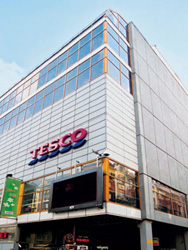
The ministry has definitively decided that May will be a cultural monument
 |
Tesco Stores ČR has already received the ministry's decision and will respect it. "We are currently analyzing what impact this will have on the future operation of the department store," said Tesco Stores ČR spokesperson Jana Matoušková today. She added that the company would need to reassess its plans for the reconstruction of the department store so that the repairs comply with the ministry's decision.
"The minister found that the ministry's decision was made in accordance with the heritage preservation law and administrative procedure," the spokesperson stated. According to her, it was reliably established in the proceedings that the building meets the legally prescribed conditions for being declared a cultural monument, as it represents an important example of architecture from the 1970s. It is also significant in a European context, linking to the interwar functionalist architecture and anticipating the architectural interpretation of the high-tech style in its interior, the spokesperson noted.
The Culture Minister found no relevant reasons to change or annul the contested decision, and therefore the appeal was rejected and the contested decision was confirmed, she stated. The minister rejected the appeal on December 21, 2006.
The proposal to declare Máj a cultural monument was submitted last March by architectural historian Rostislav Švácha, among other things in reaction to the fact that the owner of the building initially planned its demolition and then a comprehensive reconstruction.
"If the owner of this cultural monument wishes to carry out maintenance, restoration, or structural modifications to the building, they must request a binding opinion from the Department of Culture and Heritage Preservation of the Prague Magistrate, which is the authority responsible for state administration in the field of heritage preservation in this case," the spokesperson added. The relevant department of the magistrate then requests a professional opinion from the National Heritage Institute before issuing a binding opinion.
The question of whether Máj will enjoy heritage protection was important as a precedent. Buildings so young are the subject of disputes among art historians, heritage preservationists, local governments, and owners of these facilities about whether they deserve protection. The perspective of the general public on this matter may also be problematic, as most laypeople still associate the term heritage primarily with historical objects.
Máj was completed in 1975, built on the site of the neo-Gothic Šlik Palace according to a design by Miroslav Masák, John Eisler, and Martin Rajniš from the Liberec studio SIAL, which was founded in 1968 by the author of the television tower in Ještěd, Karel Hubáček. According to Švácha, Máj's architecture develops the impulses of this unique work but also promptly responds to the challenge posed by the 1972 project of the Paris museum Centre Georges Pompidou by the pioneers of the high-tech style Renzo Piano and Richard Rogers.
The declaration of Máj as a monument does not obstruct its modifications. The status of a monument only ensures that the features that have already provided it with historical significance will not be erased, believes Švácha. He believes that there are architects who could design a respectful reconstruction of Máj - including the original authors.
The English translation is powered by AI tool. Switch to Czech to view the original text source.
0 comments
add comment
Related articles
0
18.02.2019 | The Prague department store Máj bought Amádeus Real from Tesco
0
02.03.2018 | The department store Máj is a significant representative of 1970s architecture
0
02.03.2018 | Tesco sells the department store My in the center of Prague
0
19.04.2015 | <translation>Department store Máj celebrates 40 years since its opening</translation>












